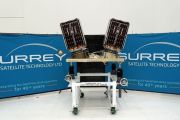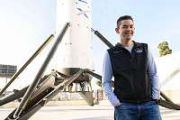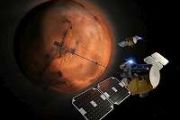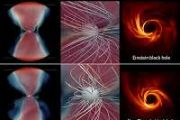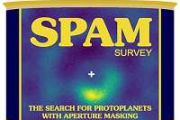
Copernical Team
The future of NASA's laser communications
 NASA uses lasers to send information to and from Earth, employing invisible beams to traverse the skies, sending terabytes of data - pictures and videos - to increase our knowledge of the universe. This capability is known as laser, or optical, communications, even though these eye-safe, infrared beams can't be seen by human eyes.
"We are thrilled by the promise laser communications will o
NASA uses lasers to send information to and from Earth, employing invisible beams to traverse the skies, sending terabytes of data - pictures and videos - to increase our knowledge of the universe. This capability is known as laser, or optical, communications, even though these eye-safe, infrared beams can't be seen by human eyes.
"We are thrilled by the promise laser communications will o Northwestern rocket to image supernova remnant
 A Northwestern University astrophysics team is aiming for the stars - well, a dead star, that is.
On Aug. 21, the NASA-funded team will launch its "Micro-X" rocket from White Sands Missile Range in southern New Mexico. The rocket will spend 15 minutes in space - just enough time to snap a quick image of supernova remnant Cassiopeia A, a star in the Cassiopeia constellation that exploded ap
A Northwestern University astrophysics team is aiming for the stars - well, a dead star, that is.
On Aug. 21, the NASA-funded team will launch its "Micro-X" rocket from White Sands Missile Range in southern New Mexico. The rocket will spend 15 minutes in space - just enough time to snap a quick image of supernova remnant Cassiopeia A, a star in the Cassiopeia constellation that exploded ap Meteorite provides record of asteroids "spitting out" pebbles
 In 2019, NASA's OSIRIS-REx spacecraft sent back images of a geological phenomenon no one had ever seen before: pebbles were flying off the surface of the asteroid Bennu. The asteroid appeared to be shooting off swarms of marble-sized rocks. Scientists had never seen this behavior from an asteroid before, and it's a mystery exactly why it happens. But in a new paper in Nature Astronomy, researche
In 2019, NASA's OSIRIS-REx spacecraft sent back images of a geological phenomenon no one had ever seen before: pebbles were flying off the surface of the asteroid Bennu. The asteroid appeared to be shooting off swarms of marble-sized rocks. Scientists had never seen this behavior from an asteroid before, and it's a mystery exactly why it happens. But in a new paper in Nature Astronomy, researche New study of moon rocks finds they contain gases from Earth
 A new study of six moon rocks has discovered proof that the moon includes chemical elements from Earth's interior - a finding that supports the theory that the moon was created when something smashed into Earth.
Doctoral research by Patricia Will at ETH Zurich found that six lunar meteorites found in Antarctica contained traces of helium and neon. Those gases, called noble gases, rarel
A new study of six moon rocks has discovered proof that the moon includes chemical elements from Earth's interior - a finding that supports the theory that the moon was created when something smashed into Earth.
Doctoral research by Patricia Will at ETH Zurich found that six lunar meteorites found in Antarctica contained traces of helium and neon. Those gases, called noble gases, rarel Yale project brings creative expression to space flight
 Picture a spacesuit. It's functional, and the mirrored visor is fun. But you can't dance in it. While the first astronaut to set foot on Mars probably won't pirouette or perform a jazz split on the planet's rust-colored soil, folks at Yale are nonetheless thinking about how to encourage artistic expression in space exploration.
In the spring course "The Mechanical Artifact: Ultra Space," Y
Picture a spacesuit. It's functional, and the mirrored visor is fun. But you can't dance in it. While the first astronaut to set foot on Mars probably won't pirouette or perform a jazz split on the planet's rust-colored soil, folks at Yale are nonetheless thinking about how to encourage artistic expression in space exploration.
In the spring course "The Mechanical Artifact: Ultra Space," Y Fleet Space' Exosphere Earth Scanning Technology tested at lithium exploration site
 Fleet Space Technologies is delighted to announce the successful completion of a trial using its proprietary Ambient Noise Tomography (ANT) technology to faster and non-invasively find critical lithium deposits.
This was commissioned by Australia's newest lithium miner, Core Lithium, at its Finniss Project in Australia's Northern Territory. This is in line with its mission to provide the g
Fleet Space Technologies is delighted to announce the successful completion of a trial using its proprietary Ambient Noise Tomography (ANT) technology to faster and non-invasively find critical lithium deposits.
This was commissioned by Australia's newest lithium miner, Core Lithium, at its Finniss Project in Australia's Northern Territory. This is in line with its mission to provide the g HKATG tooling up for satellite mass production
 Hong Kong Aerospace Technology Group Limited (01725. HK), which is committed to promoting Hong Kong's industrialization and supporting Hong Kong's becoming an international innovation and technology hub announced on 2 August 2022 that HKSML, its indirect wholly-owned subsidiary entered into a fit-out contract regarding the 2/F and 8/F Advanced Manufacturing Centre (AMC) in Tseung Kwan O. The con
Hong Kong Aerospace Technology Group Limited (01725. HK), which is committed to promoting Hong Kong's industrialization and supporting Hong Kong's becoming an international innovation and technology hub announced on 2 August 2022 that HKSML, its indirect wholly-owned subsidiary entered into a fit-out contract regarding the 2/F and 8/F Advanced Manufacturing Centre (AMC) in Tseung Kwan O. The con Intelsat and OneWeb partnership brings multi-orbit connectivity to airlines worldwide
 Leading satellite communications companies OneWeb and Intelsat have signed a global distribution partnership agreement to offer airlines a seamless inflight connectivity (IFC) solution with the best combination of performance, coverage, and reliability on the market.
The partnership enables Intelsat to distribute OneWeb's ground-breaking low Earth orbit (LEO) satellite services to airlines
Leading satellite communications companies OneWeb and Intelsat have signed a global distribution partnership agreement to offer airlines a seamless inflight connectivity (IFC) solution with the best combination of performance, coverage, and reliability on the market.
The partnership enables Intelsat to distribute OneWeb's ground-breaking low Earth orbit (LEO) satellite services to airlines Antaris close seed funding round to accelerate development of software solutions for space
WVU space robotics research helps Mars rovers find their footing
 West Virginia University scientists have developed a way for extraplanetary rovers to use nonvisual information to maneuver over treacherous terrain. This research aims to prevent losses like that of the Martian exploration rover Spirit, which ceased communications after its wheels became trapped in invisibly shifting sands in 2010.
Space roboticist Cagri Kilic, a Statler College of Engine
West Virginia University scientists have developed a way for extraplanetary rovers to use nonvisual information to maneuver over treacherous terrain. This research aims to prevent losses like that of the Martian exploration rover Spirit, which ceased communications after its wheels became trapped in invisibly shifting sands in 2010.
Space roboticist Cagri Kilic, a Statler College of Engine 











